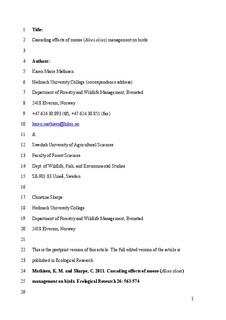Cascading effects of moose (Alces alces) management on birds
Journal article, Peer reviewed
Permanent lenke
http://hdl.handle.net/11250/134460Utgivelsesdato
2011Metadata
Vis full innførselSamlinger
Originalversjon
Mathisen, K. M., & Skarpe, C. (2011). Cascading effects of moose (Alces alces) management on birds. Ecological research, 26(3), 563-574. doi: 10.1007/s11284-011-0815-6 http://dx.doi.org/10.1007/s11284-011-0815-6Sammendrag
Large herbivores often have key functions in their ecosystems, and may change ecosystem processes with cascading effects on other animals. The mechanisms often involve relocations of resources of various kinds, including reduction in resource availability following large herbivore foraging and increase in resources from animal excreta. As large herbivore populations in Europe generally are intensely managed, management activities may interact with the activities of the herbivores themselves in the effect on other ecosystem components. We investigated the effects of moose (Alces alces) winter browsing, together with the effect of net nutrient input via supplementary winter feeding of moose on functional composition and species richness of birds in a boreal forest. Supplementary feeding stations for moose had a net zero effect on bird species richness and abundance, because negative effects of moose browsing were balanced by positive effects of nutrient input. Sites with a similar browsing intensity as at feeding stations but without nutrient input had lower abundance and species richness than feeding stations. Functional groups of bird species showed differing responses: Birds nesting at or below browsing height were negatively affected by moose browsing, whereas species nesting above the browsing zone were positively affected by moose browsing. Insect eating species responded negatively to moose browsing on birch but positively to nutrient input at feeding stations, whereas seed eating species responded positively to birch browsing and negatively to feeding stations. This study showed that both high levels of cervid activity and human management interventions influenced the bird community.
Beskrivelse
This is the preprint version of the article
